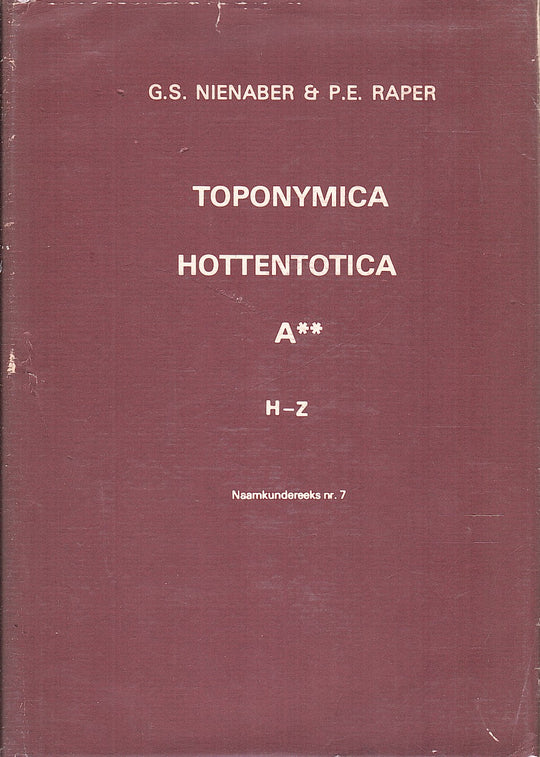Tsaurob, Tsaurab
The first syllable is like Nama Tsau- = puts. If the second syllable is a -ro-b, then understand as the diminutiefformance, so: 'Little pits', with the -B as location. So it is also explained by Dr. Vedder. We have deals. The fact is that the name for the farms in older notes appear as Tsaurab No. 106, and Tsaurab-Ost No. 105, with a -ra-b (not -ro-b), so in the addressiocher and on the owned cartridge. We believe the -ro-B is a maladjustment later. The old name is likely to declare as 'mopane tree', the 'place (-b) where there is mopane trees (tsaura)'. Cfg. about. TSAURAHEIB 1713. If botanically, it is unlikely, then like Nama tsaura- = soft (s) (Rest 1960 DNW 51), D.I. 'Softness', eg. due to sand or humid soil.
About this item
Identifier
2848_SKCPN
Title
Tsaurob, Tsaurab
Alternative Title
Tsaurob, Tsaurab
Georeference Sources
S 2318
Is Part Of
longitude
18.5
latitude
-23.5
Measurement Accuracy
50 km radius
Source
eng
PNK 1947 'Tsaurob', 40 km from Gomuchab, carbus stop on the same name. 'Nama: Tsaurob = Brunnnen (von tsub = brunnen). H. Vedder '. Brechenmacher 1973 Boer questionnaire 'Tsaurob (also called tsaurab), farm, 126 km north of Mariental. Means 'cold wells' (as I have learned), because of a puts that no longer exist '. SAP Rehoboth 1974 Interview 'Tsaurab is' soft, or soft '.'
afr
PNK 1947 'Tsaurob', 40 km van Gomuchab, motorbushalte op plaas van dieselfde naam. 'Nama: Tsaurob = Briinnlein (von tsaub = Brunnen). H. Vedder'. Brechenmacher 1973 Boer Vraelys 'Tsaurob (word ook Tsaurab genoem), plaas, 126 km noord van Mariental. Beteken ‘Koue puts’ (soos ek verneem het), weens ’n puts wat nie meer bestaan nie'. SAP Rehoboth 1974 Ondervraging 'Tsaurab is ‘Saggies, of Sagte’.'
Description
eng
The first syllable is like Nama Tsau- = puts. If the second syllable is a -ro-b, then understand as the diminutiefformance, so: 'Little pits', with the -B as location. So it is also explained by Dr. Vedder. We have deals. The fact is that the name for the farms in older notes appear as Tsaurab No. 106, and Tsaurab-Ost No. 105, with a -ra-b (not -ro-b), so in the addressiocher and on the owned cartridge. We believe the -ro-B is a maladjustment later. The old name is likely to declare as 'mopane tree', the 'place (-b) where there is mopane trees (tsaura)'. Cfg. about. TSAURAHEIB 1713. If botanically, it is unlikely, then like Nama tsaura- = soft (s) (Rest 1960 DNW 51), D.I. 'Softness', eg. due to sand or humid soil.
afr
Die eerste lettergreep is dan soos Nama tsau- = puts. Indien die tweede lettergreep 'n -ro-b is, dan wel te begryp as die diminutiefformans, dus: 'Kleinputs', met die -b as lokativering. So word dit ook verklaar deur dr Vedder. Ons het bedenkings. Feit is dat die naam vir die plase in ouer optekeninge voorkom as Tsaurab nr 106, en Tsaurab-Ost nr 105, met ’n -ra-b (nie -ro-b) nie, so in die Adressbiicher en op die Besitzkarten. Ons meen dat die -ro-b 'n wanaanpassing is van later. Die ou naam is waarskynlik te verklaar as 'Mopanieboomplek', die 'Plek (-b) waar daar mopaniebome (tsaura-) staan'. Vgl. o.m. TSAURAHEIB 1713. Indien dit botanies onwaarskynlik is, dan soos Nama tsaura- = sag(te) (Rust 1960 DNW 51), d.i. 'Sagteplek', bv. vanweë sand of vogtige bodem.
page start
1053




